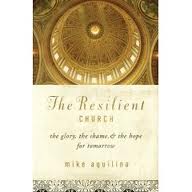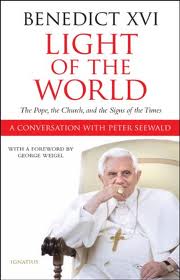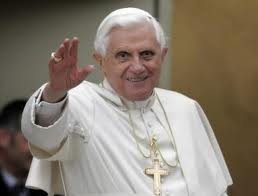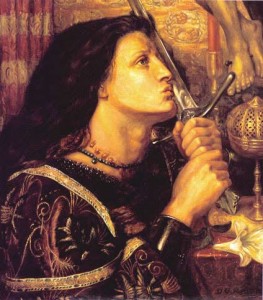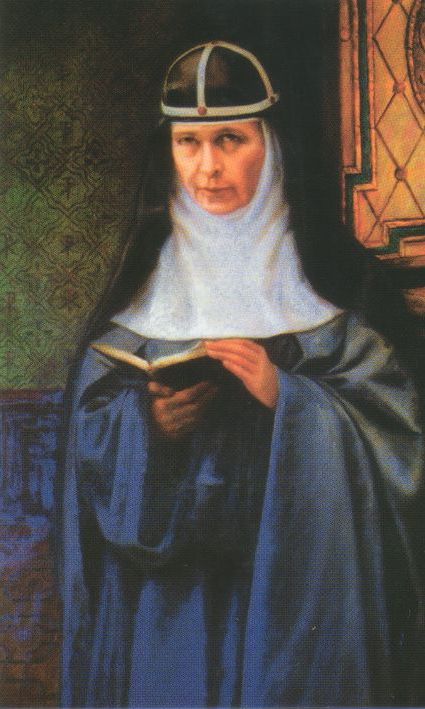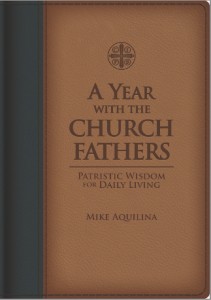Episode 5– Light in the Dark Ages
The Resilient Church with Mike Aquilina, offers a fascinating look at the trials and triumphs of the Catholic Church over the past two thousand years. Fast-paced sketches of critical periods in church history give readers perspective on the challenges faced by the church today. Mike Aquilina does not shrink from the realities of the past, including badly behaved leaders and those who betrayed the Lord. Yet he also leaves us all with well-founded hope for the future: God remains faithful in every circumstance and fulfills his promise to remain with his church always. Hosted by Kris McGregor
Also visit Mike’s “Discerning Hearts†page for more audio downloads and information!
Tags: benedictines, catholic, catholic podcast, catholic prayer, cathollc spirituality, Light in the Dark Ages The Resilient Church, middle ages, mike aquilina, Resilient Church, st. paul center for biblical theology
This entry was posted on Tuesday, May 31st, 2011 at 7:03 pm
You can follow any responses to this entry through the RSS 2.0 feed.
Episode 4 – Heresy and Orthodoxy
 The Resilient Church with Mike Aquilina, offers a fascinating look at the trials and triumphs of the Catholic Church over the past two thousand years. Fast-paced sketches of critical periods in church history give readers perspective on the challenges faced by the church today. Mike Aquilina does not shrink from the realities of the past, including badly behaved leaders and those who betrayed the Lord. Yet he also leaves us all with well-founded hope for the future: God remains faithful in every circumstance and fulfills his promise to remain with his church always. Hosted by Kris McGregor
The Resilient Church with Mike Aquilina, offers a fascinating look at the trials and triumphs of the Catholic Church over the past two thousand years. Fast-paced sketches of critical periods in church history give readers perspective on the challenges faced by the church today. Mike Aquilina does not shrink from the realities of the past, including badly behaved leaders and those who betrayed the Lord. Yet he also leaves us all with well-founded hope for the future: God remains faithful in every circumstance and fulfills his promise to remain with his church always. Hosted by Kris McGregor
Also visit Mike’s “Discerning Hearts†page for more audio downloads and information!
Tags: catholic, catholic podcast, catholic prayer, cathollc spirituality, church history, heresy, mike aquilina, orthodoxy, Resilient Church, st. paul center for biblical theology
This entry was posted on Thursday, May 19th, 2011 at 10:31 pm
You can follow any responses to this entry through the RSS 2.0 feed.
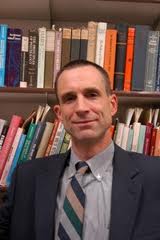 Episode 1 – What is Christian Apologetics? Who was St. Thomas Aquinas, his life, his times, and his contribution. What is “theology”? What is the “Summa”?
Episode 1 – What is Christian Apologetics? Who was St. Thomas Aquinas, his life, his times, and his contribution. What is “theology”? What is the “Summa”?
[powerpress]
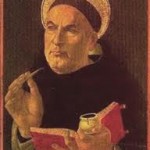 Question 1. article 1Â The nature and extent of sacred doctrine
Question 1. article 1Â The nature and extent of sacred doctrine
Whether, besides philosophy, any further doctrine is required?
Objection 1: It seems that, besides philosophical science, we have no need of any further knowledge. For man should not seek to know what is above reason: “Seek not the things that are too high for thee” (Ecclus. 3:22). But whatever is not above reason is fully treated of in philosophical science. Therefore any other knowledge besides philosophical science is superfluous.
Objection 2: Further, knowledge can be concerned only with being, for nothing can be known, save what is true; and all that is, is true. But everything that is, is treated of in philosophical science—even God Himself; so that there is a part of philosophy called theology, or the divine science, as Aristotle has proved (Metaph. vi). Therefore, besides philosophical science, there is no need of any further knowledge.
On the contrary, It is written (2 Tim. 3:16): “All Scripture, inspired of God is profitable to teach, to reprove, to correct, to instruct in justice.” Now Scripture, inspired of God, is no part of philosophical science, which has been built up by human reason. Therefore it is useful that besides philosophical science, there should be other knowledge, i.e. inspired of God.
I answer that, It was necessary for man’s salvation that there should be a knowledge revealed by God besides philosophical science built up by human reason. Firstly, indeed, because man is directed to God, as to an end that surpasses the grasp of his reason: “The eye hath not seen, O God, besides Thee, what things Thou hast prepared for them that wait for Thee” (Is. 66:4). But the end must first be known by men who are to direct their thoughts and actions to the end. Hence it was necessary for the salvation of man that certain truths which exceed human reason should be made known to him by divine revelation. Even as regards those truths about God which human reason could have discovered, it was necessary that man should be taught by a divine revelation; because the truth about God such as reason could discover, would only be known by a few, and that after a long time, and with the admixture of many errors. Whereas man’s whole salvation, which is in God, depends upon the knowledge of this truth. Therefore, in order that the salvation of men might be brought about more fitly and more surely, it was necessary that they should be taught divine truths by divine revelation. It was therefore necessary that besides philosophical science built up by reason, there should be a sacred science learned through revelation.
Reply to Objection 1: Although those things which are beyond man’s knowledge may not be sought for by man through his reason, nevertheless, once they are revealed by God, they must be accepted by faith. Hence the sacred text continues, “For many things are shown to thee above the understanding of man” (Ecclus. 3:25). And in this, the sacred science consists.
Reply to Objection 2: Sciences are differentiated according to the various means through which knowledge is obtained. For the astronomer and the physicist both may prove the same conclusion: that the earth, for instance, is round: the astronomer by means of mathematics (i.e. abstracting from matter), but the physicist by means of matter itself. Hence there is no reason why those things which may be learned from philosophical science, so far as they can be known by natural reason, may not also be taught us by another science so far as they fall within revelation. Hence theology included in sacred doctrine differs in kind from that theology which is part of philosophy.
For an online version of St. Thomas Aquinas’ “Summa” click here
“Christian Apologetics with Dr. R. R. Reno” explores numerous facets of faith and reason in the life of the Church and the world. Grounded on the work of giants, such as St. Thomas Aquinas, St. Bonaventure, Blessed John Newman, soon-to-be Blessed John Paul II, G. K. Chesterton, Blaise Paschal and Stephen Barr, Dr. Reno helps us to open our minds to make the journey to our hearts.
R. R. Reno is the editor at First Things: A Journal of Religion, Culture, and Public Life, and Professor of Theology, currently on leave from Creighton University. His theological work has been published in many academic journals. Essays and opinion pieces on religion, public life, contemporary culture, and current events have appeared in Commentary, and the Washington Post. In Fighting the Noonday Devil Reno suggests that putting ourselves at the disposal of what is real is what trains us for true piety. His other recent books include Genesis: Brazos Theological Commentary on the Bible and Sanctified Vision: An Introduction to Early Christian Interpretation of the Bible.
Tags: Blessed John Newman, catholic, catholic podcast, catholic prayer, cathollc spirituality, creighton university, faith, first things, r r reno, summa theologica, thomas aquinas, work
This entry was posted on Wednesday, May 4th, 2011 at 8:25 am
You can follow any responses to this entry through the RSS 2.0 feed.
Episode 3 – The Case for Christianity
The Resilient Church with Mike Aquilina, offers a fascinating look at the trials and triumphs of the Catholic Church over the past two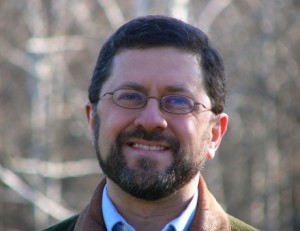 thousand years. Fast-paced sketches of critical periods in church history give readers perspective on the challenges faced by the church today. Mike Aquilina does not shrink from the realities of the past, including badly behaved leaders and those who betrayed the Lord. Yet he also leaves us all with well-founded hope for the future: God remains faithful in every circumstance and fulfills his promise to remain with his church always. Hosted by Kris McGregor
thousand years. Fast-paced sketches of critical periods in church history give readers perspective on the challenges faced by the church today. Mike Aquilina does not shrink from the realities of the past, including badly behaved leaders and those who betrayed the Lord. Yet he also leaves us all with well-founded hope for the future: God remains faithful in every circumstance and fulfills his promise to remain with his church always. Hosted by Kris McGregor
Also visit Mike’s “Discerning Hearts†page for more audio downloads and information!
Tags: catholic, catholic podcast, catholic prayer, cathollc spirituality, church history, mike aquilina, Resilient Church, st. paul center for biblical theology
This entry was posted on Sunday, May 1st, 2011 at 6:24 pm
You can follow any responses to this entry through the RSS 2.0 feed.
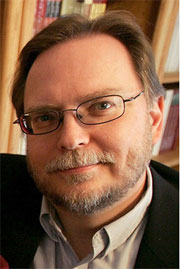 I can’t get enough from Pope Benedict XVI, especially when he shares with all of us his innermost thoughts and insights! “Light of the World: The Pope, The Church and the Signs of the Times” by Peter Seewald had such a fascinating conversation with our Holy Father that it seems to be the gift that just keeps giving. Mark Brumley took time out of his busy day as president of Ignatius Press to shed more “light” on this incredible book and the pontificate of Pope Benedict XVI.
I can’t get enough from Pope Benedict XVI, especially when he shares with all of us his innermost thoughts and insights! “Light of the World: The Pope, The Church and the Signs of the Times” by Peter Seewald had such a fascinating conversation with our Holy Father that it seems to be the gift that just keeps giving. Mark Brumley took time out of his busy day as president of Ignatius Press to shed more “light” on this incredible book and the pontificate of Pope Benedict XVI.
[powerpress]
Check out more on the book here
Tags: catholic, catholic podcast, catholic prayer, cathollc spirituality, holy father, ignatius press, mark brumley, peter seewald, pope benedict xvi
This entry was posted on Monday, April 11th, 2011 at 5:17 pm
You can follow any responses to this entry through the RSS 2.0 feed.
Episode 2 – The Martyr’s Cup
The Resilient Church with Mike Aquilina, offers a fascinating look at the trials and triumphs of the Catholic Church over the past two thousand years. Fast-paced sketches of critical periods in church history give readers perspective on the challenges faced by the church today. Mike Aquilina does not shrink from the realities of the past, including badly behaved leaders and those who betrayed the Lord. Yet he also leaves us all with well-founded hope for the future: God remains faithful in every circumstance and fulfills his promise to remain with his church always. Hosted by Kris McGregor
thousand years. Fast-paced sketches of critical periods in church history give readers perspective on the challenges faced by the church today. Mike Aquilina does not shrink from the realities of the past, including badly behaved leaders and those who betrayed the Lord. Yet he also leaves us all with well-founded hope for the future: God remains faithful in every circumstance and fulfills his promise to remain with his church always. Hosted by Kris McGregor
Also visit Mike’s “Discerning Hearts†page for more audio downloads and information!
Tags: catholic, catholic podcast, catholic prayer, cathollc spirituality, church history, mike aquilina, Resilient Church
This entry was posted on Monday, April 4th, 2011 at 10:46 am
You can follow any responses to this entry through the RSS 2.0 feed.
Episode 1 – History, with Arms Upraised
The Resilient Church with Mike Aquilina, offers a fascinating look at the trials and triumphs of the Catholic Church over the past two thousand years. Fast-paced sketches of critical periods in church history give readers perspective on the challenges faced by the church today. Mike Aquilina does not shrink from the realities of the past, including badly behaved leaders and those who betrayed the Lord. Yet he also leaves us all with well-founded hope for the future: God remains faithful in every circumstance and fulfills his promise to remain with his church always. Hosted by Kris McGregor
thousand years. Fast-paced sketches of critical periods in church history give readers perspective on the challenges faced by the church today. Mike Aquilina does not shrink from the realities of the past, including badly behaved leaders and those who betrayed the Lord. Yet he also leaves us all with well-founded hope for the future: God remains faithful in every circumstance and fulfills his promise to remain with his church always. Hosted by Kris McGregor
Also visit Mike’s “Discerning Hearts†page for more audio downloads and information!
Tags: catholic, catholic podcast, catholic prayer, cathollc spirituality, church history, early church, mike aquilina, Resilient Church, st. paul center for biblical theology
This entry was posted on Sunday, March 27th, 2011 at 9:19 am
You can follow any responses to this entry through the RSS 2.0 feed.
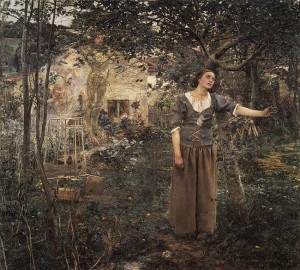 ommitment to sacramental life and to prayer: daily participation in Mass, frequent Confession and Communion and long periods of silent prayer before the Crucified One or the image of Our Lady. The young French peasant girl’s compassion and dedication in the face of her people’s suffering were intensified by her mystical relationship with God. One of the most original aspects of this young woman’s holiness was precisely this link between mystical experience and political mission. The years of her hidden life and her interior development were followed by the brief but intense two years of her public life: a year of action and a year of passion. At the beginning of 1429, Joan began her work of liberation. The many witnesses show us this young woman who was only 17 years old as a very strong and determined person, able to convince people who felt insecure and discouraged. Overcoming all obstacles, she met the Dauphin of France, the future King Charles VII, who subjected her to an examination in Poitiers by some theologians of the university. Their opinion was positive: they saw in her nothing evil, only a good Christian. On 22 March 1429 Joan dictated an important letter to the King of England and to his men at arms who were besieging the city of Orléans (ibid., pp. 221-222). Hers was a true proposal of peace in justice between the two Christian peoples in light of the Name of Jesus and Mary, but it was rejected and Joan had to gird herself to fight for the city’s liberation which took place on 8 May. The other culminating moment of her political action was the coronation of King Charles VII in Rheims on 17 July 1429. For a whole year, Joan lived with the soldiers, carrying out among them a true mission of evangelization. Many of them testified to her goodness, her courage and her extraordinary purity. She was called by all and by herself “La pucelle†(“the Maidâ€), that is, virgin. Joan’s passion began on 23 May 1430, when she fell into enemy hands and was taken prisoner. On 23 December she was led to the city of Rouen. There the long and dramatic Trial of Condemnation took place, that began in February 1431 and ended on 30 May with her being burned at the stake.
ommitment to sacramental life and to prayer: daily participation in Mass, frequent Confession and Communion and long periods of silent prayer before the Crucified One or the image of Our Lady. The young French peasant girl’s compassion and dedication in the face of her people’s suffering were intensified by her mystical relationship with God. One of the most original aspects of this young woman’s holiness was precisely this link between mystical experience and political mission. The years of her hidden life and her interior development were followed by the brief but intense two years of her public life: a year of action and a year of passion. At the beginning of 1429, Joan began her work of liberation. The many witnesses show us this young woman who was only 17 years old as a very strong and determined person, able to convince people who felt insecure and discouraged. Overcoming all obstacles, she met the Dauphin of France, the future King Charles VII, who subjected her to an examination in Poitiers by some theologians of the university. Their opinion was positive: they saw in her nothing evil, only a good Christian. On 22 March 1429 Joan dictated an important letter to the King of England and to his men at arms who were besieging the city of Orléans (ibid., pp. 221-222). Hers was a true proposal of peace in justice between the two Christian peoples in light of the Name of Jesus and Mary, but it was rejected and Joan had to gird herself to fight for the city’s liberation which took place on 8 May. The other culminating moment of her political action was the coronation of King Charles VII in Rheims on 17 July 1429. For a whole year, Joan lived with the soldiers, carrying out among them a true mission of evangelization. Many of them testified to her goodness, her courage and her extraordinary purity. She was called by all and by herself “La pucelle†(“the Maidâ€), that is, virgin. Joan’s passion began on 23 May 1430, when she fell into enemy hands and was taken prisoner. On 23 December she was led to the city of Rouen. There the long and dramatic Trial of Condemnation took place, that began in February 1431 and ended on 30 May with her being burned at the stake.
It was a great and solemn Trial, at which two ecclesiastical judges presided, Bishop Pierre Cauchon and the Inquisitor Jean le Maistre, but in fact it was conducted entirely by a large group of theologians from the renowned University of Paris, who took part in the Trial as assessors. They were French clerics, who, on the side politically opposed to Joan’s, had a priori a negative opinion of both her and her mission. This Trial is a distressing page in the history of holiness and also an illuminating page on the mystery of the Church which, according to the words of the Second Vatican Council, is “at once holy and always in need of purification†(Lumen Gentium, n. 8).
The Trial was the dramatic encounter between this Saint and her judges, who were clerics. Joan was accused and convicted by them, even condemned as a heretic and sent to the terrible death of being burned at the stake. Unlike the holy theologians who had illuminated the University of Paris, such as St Bonaventure, St Thomas Aquinas and Bl. Duns Scotus, of whom I have spoken in several Catecheses, these judges were theologians who lacked charity and the humility to see God’s action in this young woman. The words of Jesus, who said that God’s mysteries are revealed to those who have a child’s heart while they remain hidden to the learned and the wise who have no humility (cf. Lk 10:21), spring to mind. Thus, Joan’s judges were radically incapable of understanding her or of perceiving the beauty of her soul. They did not know that they were condemning a Saint. Joan’s appeal to the Pope, on 24 May, was rejected by the tribunal. On the morning of 30 May, in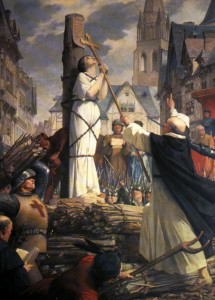 prison, she received Holy Communion for the last time and was immediately led to her torture in the Old Market Square. She asked one of the priests to hold up a processional Cross in front of the stake. Thus she died, her gaze fixed upon the Crucified Jesus and crying out several times the Name of Jesus (PNul, I, p. 457; cf. Catechism of the Catholic Church, n. 435). About 25 years later the Trial of Nullity, which opened under the authority of Pope Calixtus III, ended with a solemn sentence that declared the condemnation null and void (7 July 1456; PNul, II, pp. 604-610). This long trial, which collected the evidence of witnesses and the opinions of many theologians, all favourable to Joan, sheds light on her innocence and on her perfect fidelity to the Church. Joan of Arc was subsequently canonized by Benedict XV in 1920. Dear brothers and sisters, the Name of Jesus, invoked by our Saint until the very last moments of her earthly life was like the continuous breathing of her soul, like the beating of her heart, the centre of her whole life. The Mystery of the Charity of Joan of Arc which so fascinated the poet Charles Péguy was this total love for Jesus and for her neighbour in Jesus and for Jesus. This Saint had understood that Love embraces the whole of the reality of God and of the human being, of Heaven and of earth, of the Church and of the world. Jesus always had pride of place in her life, in accordance to her beautiful affirmation: “We must serve God first†(PCon, I, p. 288; cf. Catechismo della Chiesa Cattolica, n. 223). Loving him means always doing his will. She declared with total surrendur and trust: “I entrust myself to God my Creator, I love him with my whole my heart†(PCon, I, p. 337). With the vow of virginity, Joan consecrated her whole being exclusively to the one Love of Jesus: “it was the promise that she made to Our Lord to preserve the virginity of her body and her mind well†(PCon, I, pp. 149-150). Virginity of soul is the state of grace, a supreme value, for her more precious than life. It is a gift of God which is to be received and preserved with humility and trust. One of the best known texts of the first Trial concerns precisely this: “Asked if she knew that she was in God’s grace, she replied: ‘If I am not, may it please God to put me in it; if I am, may it please God to keep me there’†(ibid., p. 62; cf. Catechism of the Catholic Church, n. 2005).
prison, she received Holy Communion for the last time and was immediately led to her torture in the Old Market Square. She asked one of the priests to hold up a processional Cross in front of the stake. Thus she died, her gaze fixed upon the Crucified Jesus and crying out several times the Name of Jesus (PNul, I, p. 457; cf. Catechism of the Catholic Church, n. 435). About 25 years later the Trial of Nullity, which opened under the authority of Pope Calixtus III, ended with a solemn sentence that declared the condemnation null and void (7 July 1456; PNul, II, pp. 604-610). This long trial, which collected the evidence of witnesses and the opinions of many theologians, all favourable to Joan, sheds light on her innocence and on her perfect fidelity to the Church. Joan of Arc was subsequently canonized by Benedict XV in 1920. Dear brothers and sisters, the Name of Jesus, invoked by our Saint until the very last moments of her earthly life was like the continuous breathing of her soul, like the beating of her heart, the centre of her whole life. The Mystery of the Charity of Joan of Arc which so fascinated the poet Charles Péguy was this total love for Jesus and for her neighbour in Jesus and for Jesus. This Saint had understood that Love embraces the whole of the reality of God and of the human being, of Heaven and of earth, of the Church and of the world. Jesus always had pride of place in her life, in accordance to her beautiful affirmation: “We must serve God first†(PCon, I, p. 288; cf. Catechismo della Chiesa Cattolica, n. 223). Loving him means always doing his will. She declared with total surrendur and trust: “I entrust myself to God my Creator, I love him with my whole my heart†(PCon, I, p. 337). With the vow of virginity, Joan consecrated her whole being exclusively to the one Love of Jesus: “it was the promise that she made to Our Lord to preserve the virginity of her body and her mind well†(PCon, I, pp. 149-150). Virginity of soul is the state of grace, a supreme value, for her more precious than life. It is a gift of God which is to be received and preserved with humility and trust. One of the best known texts of the first Trial concerns precisely this: “Asked if she knew that she was in God’s grace, she replied: ‘If I am not, may it please God to put me in it; if I am, may it please God to keep me there’†(ibid., p. 62; cf. Catechism of the Catholic Church, n. 2005).
Our Saint lived prayer in the form of a continuous dialogue with the Lord who also illuminated her dialogue with the judges and gave her peace and security. She asked him with trust: Sweetest God, in honour of your holy Passion, I ask you, if you love me, to show me how I must answer these men of the Church†(PCon, I, p. 252). Joan saw Jesus as the “King of Heaven and of the earthâ€. She therefore had painted on her standard the image of “Our Lord holding the world†(ibid., p. 172): the emblem of her political mission. The liberation of her people was a work of human justice which Joan carried out in charity, for love of Jesus. Her holiness is a beautiful example for lay people engaged in politics, especially in the most difficult situations. Faith is the light that guides every decision, as a century later another great Saint, the Englishman Thomas More, was to testify.
In Jesus Joan contemplated the whole reality of the Church, the “Church triumphant†of Heaven, as well as the “Church militant†on earth. According to her words, “About Jesus Christ and the Church, I simply know they’re just one thing†(ibid., p. 166). This affirmation, cited in theCatechism of the Catholic Church (n. 795), has a truly heroic character in the context of theTrial of Condemnation, before her judges, men of the Church who were persecuting and condemning her. In the Love of Jesus Joan found the strength to love the Church to the very end, even at the moment she was sentenced. I like to recall that St Joan of Arc had a profound influence on a young Saint of the modern age: Thérèse of the Child Jesus. In the context of a completely different life, spent in the cloister, the Carmelite of Lisieux felt very close to Joan, living in the heart of the Church and participating in Christ’s suffering for the world’s salvation. The Church has brought them together as Patronesses of France, after the Virgin Mary. St Thérèse expressed her desire to die, like Joan, with the Name of Jesus on her lips (Manoscritto B, 3r), and she was motivated by the same great love for Jesus and her neighbour, lived in consecrated virginity. Dear brothers and sisters, with her luminous witness St Joan of Arc invites us to a high standard of Christian living: to make prayer the guiding motive of our days; to have full trust in doing God’s will, whatever it may be; to live charity without favouritism, without limits and drawing, like her, from the Love of Jesus a profound love for the Church. Thank you.
Tags: catholic, catholic church, catholic podcast, catholic prayer, cathollc spirituality, Crucified Jesus, French Saint, Joan of Arc
This entry was posted on Wednesday, January 19th, 2011 at 12:12 am
You can follow any responses to this entry through the RSS 2.0 feed.
Episode 10 – Defending Human Life: The Early Church and Abortion
Roots of the Faith – From the Church Fathers to You with Mike Aquilina, makes clear that just as an acorn grows into a tree and yet remains the same plant, so the Catholic Church is a living organism that has grown from the faith of the earliest Christians into the body of Christ we know today. Hosted by Kris McGregor
makes clear that just as an acorn grows into a tree and yet remains the same plant, so the Catholic Church is a living organism that has grown from the faith of the earliest Christians into the body of Christ we know today. Hosted by Kris McGregor
[powerpress]
Also visit Mike’s “Discerning Hearts†page for more audio downloads and information!
Tags: abortion, catholic, catholic podcast, catholic prayer, cathollc spirituality, church fathers, fathers of the church, kris mcgregor, mike aquilina, servant books
This entry was posted on Sunday, January 16th, 2011 at 12:44 pm
You can follow any responses to this entry through the RSS 2.0 feed.
It’s a story of a young man named Giovanni, a pope named Pius IX and a time when….well I’ll let Omar Guiterrez tell the story...(he’s the best kind of “storyteller” because his stories are exciting, poignant, compelling and…true)
Guiterrez tell the story...(he’s the best kind of “storyteller” because his stories are exciting, poignant, compelling and…true)
An excerpt from Omar’s Regnum Novum post entitled “Giovanni and His Rome Beneath the Surface”:
It would behoove you to know that at this time in history, not too much unlike our own, the idea that the Catholic Church as we know it actually existed before the Middle Ages was an idea largely held to be ridiculous. Certainly there was a Christianity. But surely nothing like the Church of Rome. The scathing writing of the Enlightenment thinkers from the late 18th and throughout the 19th centuries had convinced most people that the priesthood, and much more so the papacy, was a Roman Catholic myth, invented to justify their inherently corrupting hold on power. Any notion from the average man that these existed before the stupefyingly dark ages of Medieval ignorance was mere pious idiocy. Even before this time, Martin Luther wrote, in his book titled Against the Roman Papacy Instituted by the Devil (catchy title no?),
I am content to be able to say, since I have seen it and heard it at Rome, that it is unknown where in the city the bodies of Saint Peter and Paul are located, or even whether they are there at all. Even the Pope and the cardinals know very well that they do not know.
Yet, in this world of legends and stories Giovanni lived in youthful and pious bliss. So it was that one fine Spring day in 1849, the same year that the Communist Manifesto was published, and at the ripe old age of 22, whilst the Roman birds sung their sweet songs of vernal joy to travelers on the ancient Appian road, Giovanni came across a piece of marble, which looked something very much like this:
Pieces of marble were constantly being found by farmers in the area. It is just a part of living in that world where history grows from the ground like the leaves of the acanthus plant that decorates the Mediterranean. This marble was probably dug up by the farmer attempting to ready his field for planting, and he tossed it toward the road. As fate – or should I say God’s good grace – would have it Giovanni, with all his peculiar knowledge, came across it on this day and at this hour. He examined the thing and began to wonder, as only a youthful lad can and does.
He recalled from his vast reading the legend of a Pope Cornelius who had been sentenced to exile by the new emperor Gallus. The emperor was a useless fellow, who had been put into power by the Roman army after the death of the Christian-hating Decius only to be killed by that same army two years later. Poor Pope Cornelius died in exile but was referred to in the martyrologies as not just a confessor but as a martyr. Furthermore, this Pope Cornelius, who reigned as the vicar of Christ from 251-253 was said to have been brought back to Rome and buried in the legendary Crypt of the Popes in the catacomb of St. Callistus. So perhaps, thought the youthful Italian lad, perhaps this is a marker for Pope Cornelius’ grave, which would mean that he’s buried in that field somewhere, which would mean that underneath lies not just the mythic Crypt of the Popes but also the original burial place of St. Cecilia, who was later moved to the Church in Trastevere that still bears her name, and all sorts of wonders within the famed – but never discovered – catacomb of St. Callistus. Yes, this was the reasoning of young Giovanni. This was the thought process of a young lad who had not lived long enough to know that silly dreams of an ancient Church were passé and never mentioned in polite company. These were the musings of a boy who dreamed to discover something true in an age of cynical doubting. And these were the notions that Giovanni Battista de Rossi took to Pope Pius IX.
To hear the whole story take a listen, and then visit Regnum Novum for the complete text and images…it’s get’s better…it’s SO touching and compelling…and it’s true
Tags: catholic, catholic podcast, catholic prayer, cathollc spirituality, Giovanni Battista Carlo de Rossi, papacy, pope pius ix, rome beneath the surface
This entry was posted on Monday, January 10th, 2011 at 3:26 am
You can follow any responses to this entry through the RSS 2.0 feed.
Episode 8 – The Papacy: The Apostolic Throne
Roots of the Faith – From the Church Fathers to You with Mike Aquilina, makes clear that just as an acorn grows into a tree and yet remains the same plant, so the Catholic Church is a living organism that has grown from the faith of the earliest Christians into the body of Christ we know today. Hosted by Kris McGregor
makes clear that just as an acorn grows into a tree and yet remains the same plant, so the Catholic Church is a living organism that has grown from the faith of the earliest Christians into the body of Christ we know today. Hosted by Kris McGregor
[powerpress]
Also visit Mike’s “Discerning Hearts†page for more audio downloads and information!
Tags: catholic, catholic podcast, catholic prayer, cathollc spirituality, church fathers, fathers of the church, mike aquilina, papacy
This entry was posted on Saturday, November 27th, 2010 at 9:15 am
You can follow any responses to this entry through the RSS 2.0 feed.
Episode 6 – Purgatory: Love Stronger than Death
Roots of the Faith – From the Church Fathers to You with Mike Aquilina, makes clear that just as an acorn grows into a tree and yet remains the same plant, so the Catholic Church is a living organism that has grown from the faith of the earliest Christians into the body of Christ we know today. Hosted by Kris McGregor
makes clear that just as an acorn grows into a tree and yet remains the same plant, so the Catholic Church is a living organism that has grown from the faith of the earliest Christians into the body of Christ we know today. Hosted by Kris McGregor
[powerpress]
Also visit Mike’s “Discerning Hearts†page for more audio downloads and information!
Tags: catholic, catholic podcast, catholic prayer, cathollc spirituality, church fathers, kris mcgregor, mike aquilina, purgatory
This entry was posted on Friday, November 5th, 2010 at 6:22 pm
You can follow any responses to this entry through the RSS 2.0 feed.
Be sure to visit the St. Bridget Discerning Hearts page!!!
And here is an earlier Discerning Hearts post on St. Bridget!
Vatican City, Oct 27, 2010 Pope Benedict’s General Audience from vatican.va
Saint Bridget of Sweden
Dear Brothers and Sisters,
On the eve of the Great Jubilee in anticipation of the Year 2000 the Venerable Servant of God John Paul II proclaimed St Bridget of Sweden Co-Patroness of the whole of Europe. This morning I would like to present her, her message and the reasons why — still today — this holy woman has much to teach the Church and the world.
We are well acquainted with the events of St Bridget’s life because her spiritual fathers compiled her biography in order to further the process of her canonization immediately after her death in 1373. Bridget was born 70 years earlier, in 1303, in Finster, Sweden, a Northern European nation that for three centuries had welcomed the Christian faith with the same enthusiasm as that with which the Saint had received it from her parents, very devout people who belonged to noble families closely related to the reigning house.
We can distinguished two periods in this Saint’s life.
The first was characterized by her happily married state. Her husband was called Ulf and he was Governor of an important district of the Kingdom of Sweden. The marriage lasted for 28 years, until Ulf’s death. Eight children were born, the second of whom, Karin (Catherine), is venerated as a Saint. This is an eloquent sign of Bridget’s dedication to her children’s education. Moreover, King Magnus of Sweden so appreciated her pedagogical wisdom that he summoned her to Court for a time, so that she could introduce his young wife, Blanche of Namur, to Swedish culture. Bridget, who was given spiritual guidance by a learned religious who initiated her into the study of the Scriptures, exercised a very positive influence on her family which, thanks to her presence, became a true “domestic churchâ€. Together with her husband she adopted the Rule of the Franciscan Tertiaries. She generously practiced works of charity for the poor; she also founded a hospital. At his wife’s side Ulf’s character improved and he advanced in the Christian life. On their return from a long pilgrimage to Santiago de Compostela, which they made in 1341 with other members of the family, the couple developed a project of living in continence; but a little while later, in the tranquillity of a monastery to which he had retired, Ulf’s earthly life ended. This first period of Bridget’s life helps us to appreciate what today we could describe as an authentic “conjugal spiritualityâ€: together, Christian spouses can make a journey of holiness sustained by the grace of the sacrament of Marriage. It is often the woman, as happened in the life of St Bridget and Ulf, who with her religious sensitivity, delicacy and gentleness succeeds in persuading her husband to follow a path of faith. I am thinking with gratitude of the many women who, day after day, illuminate their families with their witness of Christian life, in our time too. May the Lord’s Spirit still inspire holiness in Christian spouses today, to show the world the beauty of marriage lived in accordance with the Gospel values: love, tenderness, reciprocal help, fruitfulness in begetting and in raising children, openness and solidarity to the world and participation in the life of the Church.
The second period of Bridget’s life began when she was widowed. She did not consider another marriage in order to deepen her union with the Lord through prayer, penance and charitable works. Therefore Christian widows too may find in this Saint a model to follow. In fact, upon the death of her husband, after distributing her possessions to the poor — although she never became a consecrated religious — Bridget settled near the Cistercian Monastery of Alvastra. Here began the divine revelations that were to accompany her for the rest of her life. Bridget dictated them to her confessors-secretaries, who translated them from Swedish into Latin and gathered them in eight volumes entitled Revelationes (Revelations). A supplement followed these books called, precisely,Revelationes extravagantes (Supplementary revelations).
St Bridget’s Revelations have a very varied content and style. At times the revelations are presented in the form of dialogues between the divine Persons, the Virgin, the Saints and even demons; they are dialogues in which Bridget also takes part. At other times, instead, a specific vision is described; and in yet others what the Virgin Mary reveals to her concerning the life and mysteries of the Son.
The value of St Bridget’s Revelations, sometimes the object of criticism Venerable John Paul II explained in his Letter Spes Aedificandi: “The Church, which recognized Bridget’s holiness without ever pronouncing on her individual revelations, has accepted the overall authenticity of her interior experience†(n. 5). Indeed, reading these Revelations challenges us on many important topics. For example, the description of Christ’s Passion, with very realistic details, frequently recurs. Bridget always had a special devotion to Christ’s Passion, contemplating in it God’s infinite love for human beings. She boldly places these words on the lips of the Lord who speaks to her: “O my friends, I love my sheep so tenderly that were it possible I would die many other times for each one of them that same death I suffered for the redemption of all†(Revelationes, Book I, c. 59). The sorrowful motherhood of Mary, which made her Mediatrix and Mother of Mercy, is also a subject that recurs frequently in the Revelations.
In receiving these charisms, Bridget was aware that she had been given a gift of special love on the Lord’s part: “My Daughter†— we read in the First Book of Revelations — “I have chosen you for myself, love me with all your heart… more than all that exists in the world†(c. 1). Bridget, moreover, knew well and was firmly convinced that every charism is destined to build up the Church. For this very reason many of her revelations were addressed in the form of admonishments, even severe ones, to the believers of her time, including the Religious and Political Authorities, that they might live a consistent Christian life; but she always reprimanded them with an attitude of respect and of full fidelity to the Magisterium of the Church and in particular to the Successor of the Apostle Peter.
In 1349 Bridget left Sweden for good and went on pilgrimage to Rome. She was not only intending to take part in the Jubilee of the Year 1350 but also wished to obtain from the Pope approval for the Rule of a Religious Order that she was intending to found, called after the Holy Saviour and made up of monks and nuns under the authority of the Abbess. This is an element we should not find surprising: in the Middle Ages monastic foundations existed with both male and female branches, but with the practice of the same monastic Rule that provided for the Abbess’ direction. In fact, in the great Christian tradition the woman is accorded special dignity and — always based on the example of Mary, Queen of Apostles — a place of her own in the Church, which, without coinciding with the ordained priesthood is equally important for the spiritual growth of the Community. Furthermore, the collaboration of consecrated men and women, always with respect for their specific vocation, is of great importance in the contemporary world. In Rome, in the company of her daughter Karin, Bridget dedicated herself to a life of intense apostolate and prayer. And from Rome she went on pilgrimage to various Italian Shrines, in particular to Assisi, the homeland of St Francis for whom Bridget had always had great devotion. Finally, in 1371, her deepest desire was crowned: to travel to the Holy Land, to which she went accompanied by her spiritual children, a group that Bridget called “the friends of Godâ€. In those years the Pontiffs lived at Avignon, a long way from Rome: Bridget addressed a heartfelt plea to them to return to the See of Peter, in the Eternal City. She died in 1373, before Pope Gregory XI returned to Rome definitively. She was buried temporarily in the Church of San Lorenzo in Panisperna in Rome but in 1374 her children, Birger and Karin, took her body back to her homeland, to the Monastery of Vadstena, the headquarters of the Religious Order St Bridget had founded. The order immediately experienced a considerable expansion. In 1391 Pope Boniface IX solemnly canonized her. Bridget’s holiness, characterized by the multiplicity of her gifts and the experiences that I have wished to recall in this brief biographical and spiritual outline, makes her an eminent figure in European history. In coming from Scandinavia, St Bridget bears witness to the way Christianity had deeply permeated the life of all the peoples of this Continent. In declaring her Co-Patroness of Europe, Pope John Paul II hoped that St Bridget — who lived in the 14th century when Western Christianity had not yet been wounded by division — may intercede effectively with God to obtain the grace of full Christian unity so deeply longed for.
Let us pray, dear brothers and sisters, for this same intention, which we have very much at heart, and that Europe may always be nourished by its Christian roots, invoking the powerful intercession of St Bridget of Sweden, a faithful disciple of God and Co-Patroness of Europe. Thank you for your attention.
Tags: Bridget Discerning Hearts, catholic, catholic podcast, catholic prayer, cathollc spirituality, devotion, holy women, love, motherhood, mystic, mystic of the Church, mystical expeeriences, mystical experiences, mystical revelations, pope benedict xvi, st bridget of sweden, St. Bridget, Sweden, women of the middle ages
This entry was posted on Wednesday, October 27th, 2010 at 6:07 pm
You can follow any responses to this entry through the RSS 2.0 feed.
Episode 4 – From the Scriptures to the Bible
Roots of the Faith – From the Church Fathers to You with Mike Aquilina, makes clear that just as an acorn grows into a tree and yet remains the same plant, so the Catholic Church is a living organism that has grown from the faith of the earliest Christians into the body of Christ we know today. Hosted by Kris McGregor
makes clear that just as an acorn grows into a tree and yet remains the same plant, so the Catholic Church is a living organism that has grown from the faith of the earliest Christians into the body of Christ we know today. Hosted by Kris McGregor
[powerpress]
Also visit Mike’s “Discerning Hearts†page for more audio downloads and information!
Tags: body of christ, catholic, catholic church, catholic podcast, catholic prayer, cathollc spirituality, church fathers, mike aquilina
This entry was posted on Sunday, October 17th, 2010 at 3:58 pm
You can follow any responses to this entry through the RSS 2.0 feed.
“A Year with the Church Fathers: Patristic Wisdom for Daily Living” by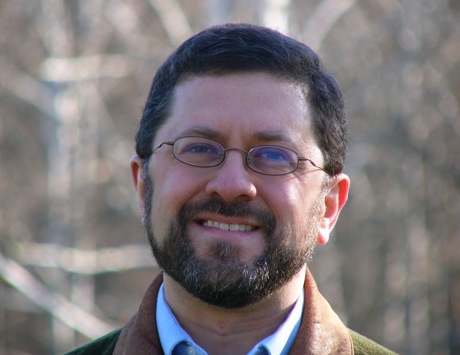 Mike Aquilina is outstanding. St. Benedict Press has produced a beatiful book worthy of the content within it’s pages. But better still is the wisdom passed down through the ages which is contextualized and offered to us by acknowledged Patristic expert, Mike Aquilina. The perfect gift for a friend, family member, or even yourself. A gift from the fathers of the Church waiting to be unwrapped!
Mike Aquilina is outstanding. St. Benedict Press has produced a beatiful book worthy of the content within it’s pages. But better still is the wisdom passed down through the ages which is contextualized and offered to us by acknowledged Patristic expert, Mike Aquilina. The perfect gift for a friend, family member, or even yourself. A gift from the fathers of the Church waiting to be unwrapped!
[powerpress]
Tags: catholic, catholic podcast, catholic prayer, cathollc spirituality, church fathers, fathers of the church, mike aquilina, Mike Aquilina More, st benedict press
This entry was posted on Thursday, October 14th, 2010 at 9:20 am
You can follow any responses to this entry through the RSS 2.0 feed.

